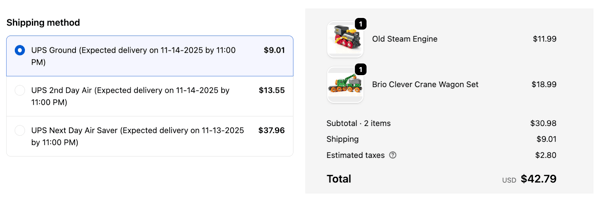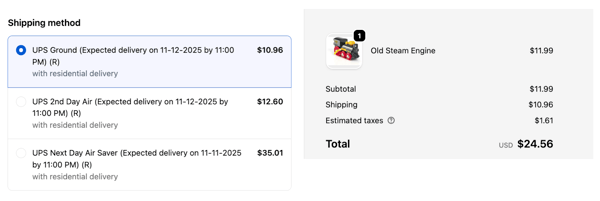A Bad Practice: Shipping Quotes On Product and Cart Pages
Why providing shipping quotes on the product pages and cart page of your e-commerce store is a bad idea.
Avoid falling victim to the bad practice of providing shipping quotes on your product pages or the cart page. In this post, we'll explore why these practices lead to unfavorable outcomes. Common reasons for avoiding these practices include:
- Shipping quotes don't scale linearly.
- The type of street address can significantly affect shipping rates.
- Shipping rate estimates provided on these pages are inherently inaccurate.
- Higher frequency of cart abandonment.
Unfavorable Product Page Issues
One of the most misleading things you can do as an e-commerce merchant is to provide real-time shipping quotes on product pages. Visitors will perceive that the shipping cost they see on each product page is additive. This is rarely the case. The additional real shipping cost of adding more items to the Cart is typically fractional, and in many cases won't change the shipping costs at all.
If your visitors are doing the math and adding up the shipping rate estimates for each item they're interested in purchasing, the shipping cost will usually be grossly overstated. This will contribute to your cart abandonment and lost sales.
Let's take a look at a few examples.
Parcel Shipping Rates
The visitor used the shipping rate estimator on the Old Steam Engine product page to get an estimated shipping rate of $9.01 for Ground service.

Afterward, the visitor used the shipping rate estimator on the Crane Wagon Set product page. The same rate of $9.01 was provided for Ground service.

Most people would conclude that the shipping cost associated with purchasing both items would be $18.02, the sum of the two shipping rates quoted on the individual product pages. However, when both products are in the Cart and the visitor proceeds to checkout, the shipping rate estimate for Ground service remains $9.01.

The reason that the shipping rate remained unchanged is that, in all three cases, the same box was used for shipping, and in each case, its dimensional weight exceeded its actual weight.
LTL Freight Rates
The visitor used the shipping rate estimator on the Drill Press product page to get a $239.61 estimate for standard LTL freight service.

Afterward, the visitor used the shipping rate estimator on the Band Saw product page. The same rate of $239.61 was provided for standard LTL freight service.

Most people would conclude that the shipping cost associated with purchasing both items would be $479.22, the sum of the two shipping rates quoted on the individual product pages. However, when both products are in the Cart and the visitor proceeds to checkout, the shipping rate estimate for standard LTL freight service remains $239.61.
The shipping rate remained unchanged because, in all three cases, the carrier's minimum charge prevailed. The physical characteristics of the products in the cart didn't yield a calculated shipping rate that exceeded the minimum shipping rate imposed by the carrier.
Unfavorable Cart Page Issues
Postponing shipping rate estimates until the cart page and avoiding their display on the product pages is an improvement. At least now you don't leave the visitor with the false impression of high shipping rates. However, the cart page has its own issue, which it shares with the product pages.
The type of address —commercial or residential —impacts the shipping rate. The address type can't be known until the street address is provided. Typically, the street address is collected only on the checkout page. The quick shipping quote forms common on product and cart pages only prompt for the city, state/province, and ZIP/postal code. In these cases, the address type is usually assumed to be commercial.
Let's look at examples of the impact on shipping rates when the address type is known.
Parcel Shipping Rates

In this case, the street address used on the checkout page is a commercial address. The rate for Ground service is $8.03.
Now, let's see the rate when the street address for the same delivery area is residential...

The rate for Ground service is $10.96; $2.93 more. In this case, the difference in price that the visitor sees between the cart page - where the street address is unknown - and the checkout page differs. The difference may be sufficient to result in an abandoned cart. It may not be. But it will likely have a negative influence on the visitor's opinion of the seller.
LTL Freight Rates
The results for LTL freight are more significant.

In this case, the street address used on the checkout page is a commercial address. The rate for standard LTL freight service is $239.61.
When the street address for the same delivery area is residential...

The cheapest shipping rate estimate is $328.61, $89.00 more. LTL freight carriers charge a significant fee for residential delivery and require liftgate delivery service, which has its own additional fee. This example is very favorable, because the additional fees for the same services from other LTL freight providers would amount to $400 or more.
What will be the impact on your brand when visitors see the charges for shipping during the checkout page increase by 40% to 180% from what was presented beforehand? Perhaps the potential customer would have accepted the shipping rate if it was only presented on the checkout page.
Conclusion
The only time accurate shipping rates can be displayed on an e-commerce store is during checkout. In every other case, there is insufficient information available to properly inform the visitor of the shipping cost. It is why the default order placement flow in all the premier e-commerce platforms wait until the checkout process to present shipping rates.
Theme developers will add functionality to the product page and cart page templates to allow for shipping rate estimates. However, these efforts are ill-advised and can only result in inaccurate estimates and damage to the seller's brand.